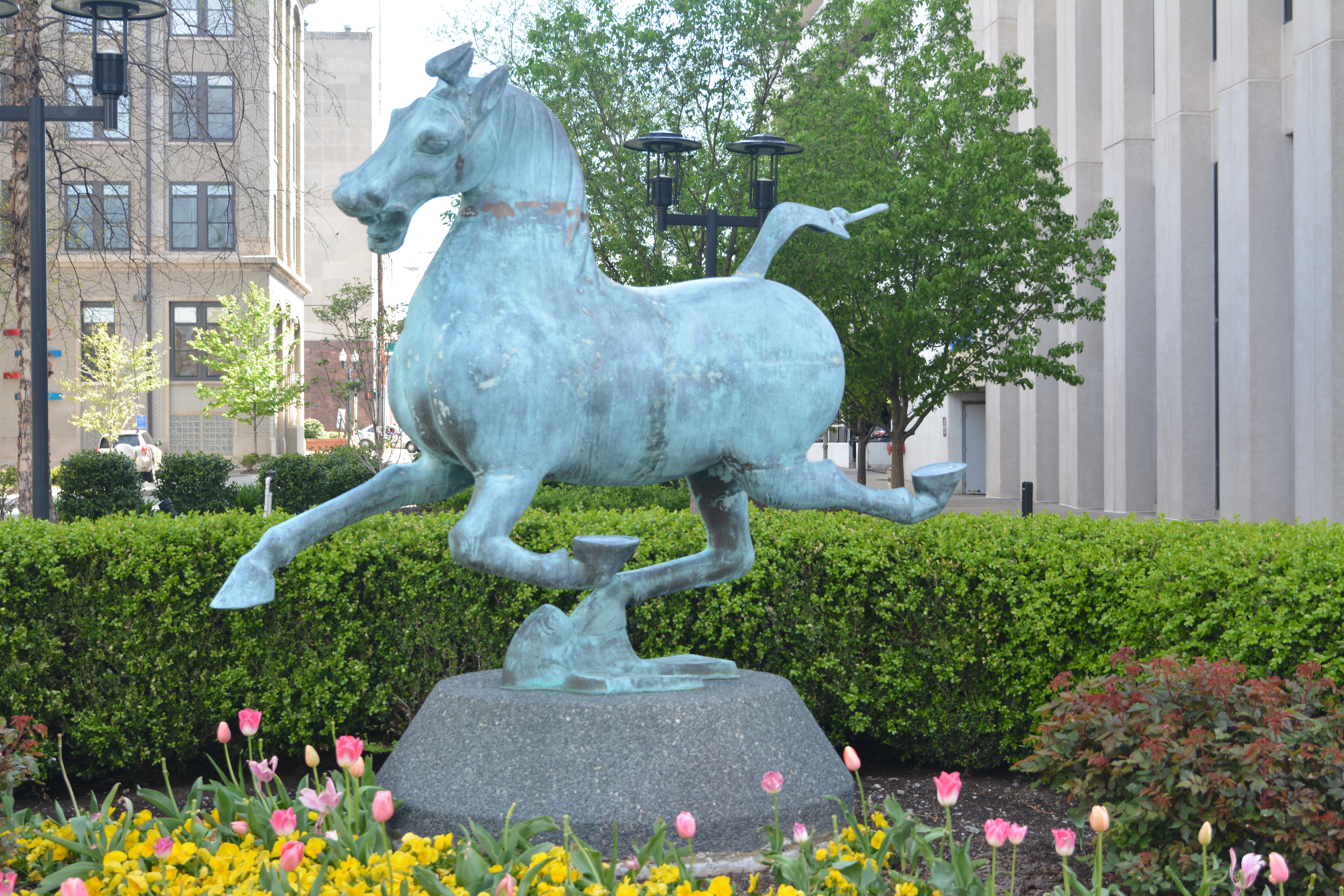Flying Horse of Gansu on:
[Wikipedia]
[Google]
[Amazon]
The ''Flying Horse of Gansu'', also known as the ''Bronze Running Horse'' (銅奔馬) or the ''Galloping Horse Treading on a Flying Swallow'' (馬踏飛燕), is a Chinese bronze sculpture from circa the 2nd century CE. Discovered in 1969 near the city of Wuwei, in the province of Gansu, it is now in the Gansu Provincial Museum. "Perfectly balanced," says one authority, "on the one hoof which rests without pressure on a flying swallow, it is a remarkable example of three-dimensional form and of animal portraiture with the head vividly expressing mettlesome vigor."
 A copy of the sculpture was donated to the city of Lexington, Kentucky, USA on June 15th, 2000 by the City of Xi'an, China and Hao Bao Zhu, President, Five Rings International.
A copy of the sculpture was donated to the city of Lexington, Kentucky, USA on June 15th, 2000 by the City of Xi'an, China and Hao Bao Zhu, President, Five Rings International.
Flying Horse of Gansu
Gansu Provincial Museum
{{Han dynasty topics Horses in art Chinese sculpture Han dynasty Bronze sculptures in China Animal sculptures in China 1969 archaeological discoveries Winged horses Horses in China
Description
The statue is made from bronze. It is 34.5 cm in height, 45 cm in length, and 13.1 cm in width.Discovery and world fame
The ''Flying Horse of Gansu'' was discovered in 1969. It was unearthed from aHan
Han may refer to:
Ethnic groups
* Han Chinese, or Han People (): the name for the largest ethnic group in China, which also constitutes the world's largest ethnic group.
** Han Taiwanese (): the name for the ethnic group of the Taiwanese p ...
tomb at Leitai in Wuwei. The tomb belonged to General Zhang of Zhangye.
The discovery was made by a team of locals who had been told to dig air-raid shelters in the case of an imminent war with the Soviet Union. During the excavations, they found a chamber under a monastery which held a group of over 200 bronze figurines of men, horses, and chariots, which they put in plastic bags and took home.
They later realized the importance of their find and reported it to provincial authorities. Professional archaeologists then took up the excavations. They discovered a three-chambered tomb which had apparently been entered by looters soon after the original burial some 2,000 years earlier. The looters had not, however, entered the chamber in which the bronzes were found. The archaeologists determined that the opulent tomb was that of a Han dynasty army general who had been given the important task of maintaining imperial frontier defenses. They took the bronzes to the museum in Lanzhou.
In Lanzhou, the group of bronzes was observed by Guo Moruo
Guo Moruo (; November 16, 1892 – June 12, 1978), courtesy name Dingtang (), was a Chinese author, poet, historian, archaeologist, and government official.
Biography
Family history
Guo Moruo, originally named Guo Kaizhen, was born on November ...
, China's elder statesman of archaeology and history, who was conducting Cambodian Prince Sihanouk on a tour of China. Guo was struck by the beauty of the horse and selected it for national and international exhibition.
The horse in the bronze is a breed brought back from Fergana
Fergana ( uz, Fargʻona/Фарғона, ), or Ferghana, is a district-level city and the capital of Fergana Region in eastern Uzbekistan. Fergana is about 420 km east of Tashkent, about 75 km west of Andijan, and less than 20 km fr ...
by a punitive expedition sent by Emperor Han Wudi
Emperor Wu of Han (156 – 29 March 87BC), formally enshrined as Emperor Wu the Filial (), born Liu Che (劉徹) and courtesy name Tong (通), was the seventh emperor of the Han dynasty of ancient China, ruling from 141 to 87 BC. His reign last ...
in 104 BCE. These " celestial horses" were highly prized as marks of status.
Although scholars pointed out that the bird was not in fact a swallow, the piece was exhibited in many countries in the 1970s as "Galloping Horse Treading on a Flying Swallow."
In 2002, the State Administration of Cultural Heritage of China included the Gansu Flying Horse in the inaugural list of 64 grade-one cultural relics that are forbidden to be taken out of mainland China for exhibition.
 A copy of the sculpture was donated to the city of Lexington, Kentucky, USA on June 15th, 2000 by the City of Xi'an, China and Hao Bao Zhu, President, Five Rings International.
A copy of the sculpture was donated to the city of Lexington, Kentucky, USA on June 15th, 2000 by the City of Xi'an, China and Hao Bao Zhu, President, Five Rings International.
References
Citations
Sources
* *External links
Flying Horse of Gansu
Gansu Provincial Museum
{{Han dynasty topics Horses in art Chinese sculpture Han dynasty Bronze sculptures in China Animal sculptures in China 1969 archaeological discoveries Winged horses Horses in China